The problem with zero volts
It is safely impossible to drop an ideal battery to zero volts. A battery cannot go down to zero volts because of the internal chemistry. In a standard use, you cannot drop the voltage below 2 volts, even if you wired the terminals together. Batteries will vary between 3.8 and 2.4 volts per cell. As voltage drops, internal resistance rises. The higher the internal resistance, the lower the current over the short circuit. I'm not personally sure what the lowest possible safe voltage for a Li-Ion cell is, but as the voltage approaches that lower limit, current will drop to almost zero. See the end of this post for a more detailed proof of this.
NOTE: The above is true for a perfect battery in a perfect world. In reality, you will badly damage the battery quickly after shorting it. At this point, internal resistance, current, and the energy difference between the half cells will all cease to matter.

(I know this graph is an alkaline, I couldn't find a diagram for a Li-ion, I assure you it looks the same)
A safe battery is a dead battery and a dead battery and a dead battery is approximately 2 volts.
If you have dropped the voltage to zero, I can tell you that you have done more than neutralize the cells, you have fundamentally altered the structure of the battery. Li-Ions are sensitive and finicky. I couldn't guess at what exactly is happening inside of a 0V battery, but I can prove to you that it can never get there (see end) and the fact that it has indicates that your battery is now in an unsafe state.
I do like what the other answer said: at 2 volts, the internal energy is ~0. This is true, and a good way to think about it.
What safety measures can I take?
As for storage, I understand wanting to store them safely. If you have concerns, there are 2 things you can protect against: fumes and fire.
To protect against fumes, store either in a well-ventilated area, or a sealed container. A lock-n-lock works well.
To protect against fire, a cinder block with a piece of tile or a paving stone on the top and bottom works well.
Regarding electrical energy, I can tell you that, unless you are talking about a battery for something absolutely massive, the electrical energy in the battery is a relatively small danger. It is the volatile nature of the chemicals which should be your biggest concern.
In summation, shorting batteries is never a good idea. Lithium-Ion batteries were designed to be stored at 2-4 volts. Use them as they were designed to be used.
Why can't I drop it to zero volts?
EDIT: Okay, so a lot of confusion seems to be coming from the battery indicators that all of us 21st-century folks are familiar with. These battery indicators are not voltage indicators and, while measuring voltage is a part of the process, determining the percent of charge remaining in your battery is not straightforward. If you used a laptop 10 years ago, you might remember the flaky battery indicators. They were flaky because calculating remaining battery life is absolutely not straightforward, but I will explain it:
Step 1: First, we need to look at the amount of current the phone is presently using and the voltage at the battery terminals.
Step 2: We can use this information to determine the internal resistance of the battery. When the internal resistance reaches infinity, the battery is completely depleted. Note that this never happens. It would take an infinite amount of time. Still, your phone knows what it's minimum voltage and current requirements in order to function. Now, if we imagine internal resistance is a resistor inline with the battery, it becomes obvious that, as that resistor's value grows there will come a point where \$ V_{battery} - R_{internal resistance} I_{minimum current} < V_{minimum voltage to run phone} \$.
Step 3: Now, we know that the internal resistance has an upper limit, and we know what the internal resistance is right now, but figuring out what percentage of battery life we are at still takes some work. The problem is that internal resistance doesn't increase linearly with consumed power and the curve that it follows is dependant on the specific battery you are using, no two batteries are exactly alike. Thus, your phone constantly tracks the battery's internal resistance and power output and uses that to constantly adapt it's battery life predictions.
Want proof? Have you ever had your phone stay on 1% battery for like 20 minutes? Or sometimes die at 2%? There you go. It's not an exact science, it's an estimate. And it's definitely way more complicated than just measuring voltage.
The scientific reason you can't drop it to zero volts
A battery is composed of two half cells. One half-cell contains dissolved and solid reactant A, the other dissolved and solid reactant B. A transfer of electrons from reactant A to reactant B will cause A to dissolve and bond with a salt, and cause B to be detached from a salt and solidify. For any given chemical reaction, there is a set amount of energy associated.
The hydrogen half cell has a potential of 0 volts, a lithium half cell has a potential of -3.04 volts, a sodium half cell has -2.71 volts. see here for more.
The reason we see the voltage decrease as the battery discharges is that the availability of chemicals in the half-cell decreases, which means that electrons will have more difficulty getting from wherever they are in one half-cell to where they need to be in the other half cell. Imagining we had two half cells each the size of a pop can and one atom of dissolved reactant A in one and one atom of solid reactant B in the other, you can imagine you aren't going to get a hell of a lot of voltage, most of the energy of the reaction will be expended just getting the electrons to the right place.
This rarity of reactants as the battery discharges means that the electrons must do more work to get from one cell to the other. This manifests as an increase in internal resistance and a decrease in CURRENT at the expense of maintaining the nominal voltage. I suppose I could begrudgingly admit that after billions of years of being connected, it is possible that you could get to zero volts when every single atom of A has been used, but the internal resistance at that point would be trivially huge, the current trivially small. Sufficient to say, after only a few minutes or hours, you would have a nominal voltage of ~2 volts.
I feel the need to clarify that I am aware this does not fit empirical data (i.e. that the voltage can be dropped to zero by wiring the cells together). I understand that. The battery ceases to behave this way because it has been badly damaged.
Still not convinced...
Okay, you have this scheme to slowly sap power away. You can't, or rather, you already have. Once it reaches a certain lower limit (close to 2 volts) you can no longer draw significant current from the battery. There are only ppm concentrations of reactants left and there is not enough of them to produce a significant current. Measure the resistance of a Li-Ion battery while drawing from it at a constant current. I searched for the graph online, all I found was Alkaline batteries, but the graph is the same for a Li-Ion. As you draw more and more, the internal resistance will reach a vertical asymptote, growing to infinity.
What actually happens after that? What happens when you try to draw more power from a battery than it can actually supply? I don't know. There are too many variables to accurately predict the reactions, breaches, etc. that could potentially take place. All I can tell you is that there is a limited amount of current in a battery, but that current will always come out at a constant voltage.
The idea of power always coming at a constant voltage seems to be troubling to you, so I ask you to think about it like this: 2 9 volt batteries have MORE voltage than a car battery. Furthermore, you can hook up 100 car batteries in parallel and still only get 12 volts.
This is because the cell-voltage is a function of the reaction: the two chemicals that are in the cell. If you made a car battery cell the size of a grain cylo, it would be 2 volts, because the reaction is two volts. If you made a car battery the size of a dime, it would be 2 volts because the reaction is two volts. Because a given electron will release a given amount of energy as it moves from point A to point B.
That said, how many electrons it is capable of pushing out at once is a function of size and a function of capacity. As the battery becomes 'dead,' it will be able to push fewer and fewer electrons as it runs out of reactant. In a billion years, it will have zero reactants left, but the reaction that isn't happening will still be a ~3-volt reaction.
This is epitomized in the unit of the Volt, which is: $$\frac{N m}{C}$$
The \$Nm\$ is a unit of work. The \$C\$ is a certain number of electrons. A volt is, therefore, a unit of work per electron-a quantity representing how much work a given electron can do. Whether there are 3 electrons or \$1 \times 10^{12}\$ electrons, they do the same amount of work each. A battery therefore only decreases in voltage because it will gain a certain internal resistance and electrons will need to do more work to get to the terminals of the battery. The reaction still releases the same energy on a per-electron basis.
I understand that this concept is difficult to understand and that there is a strong tendency to think of battery voltage as being related to the magnitude of a battery, and to how "full" it is in terms of a percentage value. Nonetheless, it is not an accurate reflection of how batteries operate, and for them to operate otherwise contradicts the very fundamentals of electrochemistry.
If at this point, you are still unconvinced, I must advise you take a course on electrochemistry, the Wikipedia page is very helpful, and I am sure there is an endless supply of YouTube tutorials on the subject matter.
But I tried this and didn't have a problem!
Cool. But the question is not "can it be done safely?" Sure, maybe there is some way to get a Li-ion to be at zero volts without emitting fumes (which you may not, for the record, be able to detect until you get sick from them). The question is not whether or not it is physically possible to do this without any explosions, the question is regarding safety. Although you may be able to do this, and although it may be safe under some circumstances, it isn't any safer than simply leaving them at 2 volts and, I would argue, that there are more risks involved.
Ultimately, it's up to you, but I can think of many reasons it is unsafe to discharge batteries this way, and see no benefit to doing so.
Please upvote or mark correct if you found this answer to be helpful

